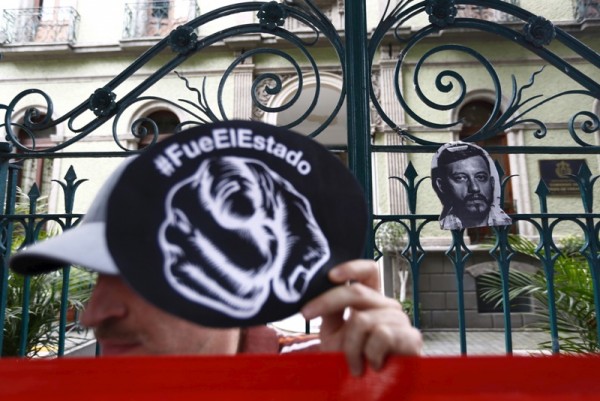The murder of photojournalist Rubén Espinosa together with four women in Mexico City on July 31 was devastating for the many Mexican journalists who have sought refuge in the streets of the capital, fleeing from death threats in their home states.
“The sense of fragility is very large,” says Daniela Pastrana, director of the organisation Periodistas de a Pie (Journalists on Foot), which offers assistance to reporters at risk in Mexico. “The killing of Rubén Espinosa has exploded the bubble of protection that Mexico City offered to many journalists who came from other parts of the country.”
“Where do I run to? Where should I go?,” wondered one female journalist who asked to remain anonymous and who has been living under police protection in Mexico City for years. “I thought that this nightmare was going to end but now I see that that it’s not.”
Mexico’s president, Enrique Peña Nieto, has now been forced to address the widespread criticism of his government. Peña Nieto has offered assurances that he will strengthen the federal protection mechanism for journalists and that he will not allow the killers of Rubén Espinosa to escape punishment.
But, for many, such promises sound empty in a country in which 89 percent of all murders and disappearances of journalists are left unsolved, according to data kept by the National Human Rights Commission (CNDH).
The statistics are difficult to digest: The organisation Article 19 has documented 88 journalist killings in Mexico over the past 15 years. According to the International Press Institute’s (IPI) Death Watch, the period between 2006 and 2012, coinciding with the government of former President Felipe Calderón’s military offensive against the drug cartels, was especially bloody: 54 journalists were murdered across the country, including 12 in Veracruz, Mexico’s deadliest state for the media.
Veracruz was Rubén Espinosa’s home. He was one of the dozens of displaced journalists who sought refuge in the anonymity offered by a metropolis of more than 20 million inhabitants.
“Being a displaced journalist is like dying and being reborn because you feel naked,” described another journalist in a telephone interview with IPI. “You don’t have a place to sleep, you don’t have food, all of your things, your belongings, your family and work, all of it, is left behind.” “Many times, he continued, “you arrive with one hand in front and the other behind. And the anxiety, the mistrust and the fear last months, and sometimes can stay with you for years.”
He also requested to remain anonymous because he fears for his life. He no longer feels safe even making his case public “with what just happened,” referring to Espinosa’s killing. “We have to think twice about giving out our names.”
The federal protection mechanism
After dedicating more than two decades to journalism, he is now considering leaving the country. “It is very difficult to trust the authorities anywhere in Mexico. We see with sadness how all of those that fill their mouths and give speeches saying that are helping journalists, in reality, aren’t doing it.”
That is not an isolated view. Numerous critics have assailed Mexico’s federal mechanism for the protection of journalists and human rights defenders, which took effect on June 25, 2012, pointing out significant failings.
The most serious, perhaps, is the slowness of the process to evaluate an applicant’s situation and to implement security measures. According to a report published by the non-governmental organisations PBI and WOLA, of the more than 197 requests for protection received by the mechanism in its first two years of operation, around 75 percent have been marked by delays in responding and including applicants in the program.
Although the government is credited with making an effort since mid-2014 to improve the mechanism and has managed, with the help of various international organisations such as Freedom House, to reduce the volume of cases pending resolution, numerous problems remain. Among them are constant changes and shortages among the staff that looks after the journalists; inadequate coordination among the various entities that are supposed to respond to a case; and inefficiency of the devices used to alert the police authorities, such as panic buttons or satellite phones.
In light of this picture, the government of Mexico’s federal capital district has also passed legislation creating a specific programme for Mexico City whose objective is to cover the multitude of reporters who arrive from all states of the country in search of a safe haven.
The programme officially came into existence on August 10 and includes measures related to social assistance, such as lodging and food, preventative and protection measures, and an emergency response system that is intended to respond to a situation of risk in less than 24 hours.
The head of the federal district government, Miguel Ángel Mancera, reiterated in a tweet his commitment guarantee refuge and protection to journalists and human rights defenders.

A picture of photojournalist Ruben Espinosa hangs from a fence as a demonstrator holds a sign that reads: “It was the state” during a protest against his murder outside the Government of Veracruz building in Mexico City, August 5, 2015. REUTERS/Edgard Garrido.
At the root of the problem: Collusion between cartels and the authorities
“After the assassination of Rubén Espinosa, you realise that safety is a utopia and that political and economic interests win out over the concepts of security and justice,” commented the female journalists under police protection.
She says has shielded herself with anonymity out of fear not only of reprisals from the cartels, but also of political pressure she received when reporting on crimes in her native state. “It was police officers themselves who came, accompanied by drug traffickers, to tell you not to photograph the scene of a car accident,” she recounted.
“And the question is,” she continued, “When am I going to get my life back? When am I going to be able to find a job or rent an apartment without fearing to give my name?”
As is always the case in such situations, behind the statistics lie stories of lives that are being lived in isolation, far from families, marked by depression, anxiety and fear. And now, after the case of Rubén Espinosa, these lives are being lived with a certain unease at how how the last bastion that offered them shelter to begin from zero is falling.
“It is very unfair to be an exile in my own country,” the female journalist concludes, “above all when you didn’t do anything wrong and you have to hide as if you were the worst of criminals.”



